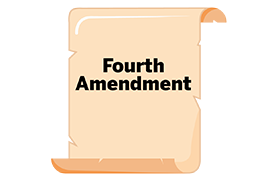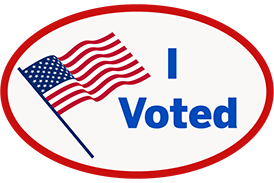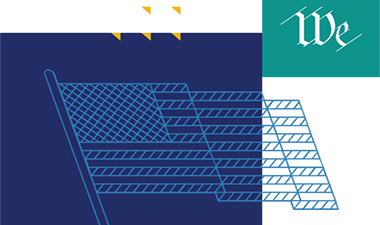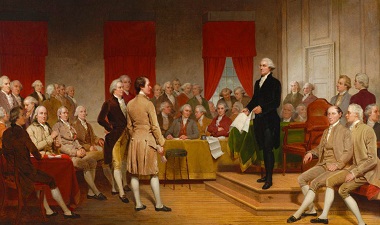
Getting Started
This module includes two Unboxing the Constitution videos (6 min. each), an Inside the Constitution video (8 min), student activities, and a learning project. Download the Teachers Guide and the Student Content Guide for more details on content and implementation. Course materials are provided in Google documents, Word documents, as well as printable PDFs.
A preview of the module can be accessed below.
Topics covered include:
- Slavery at the Founding
- Slavery throughout American history
- Abolitionists and the abolition movement
- The roots of Reconstruction

Vocabulary
At the beginning of each module, students are presented with vocabulary words and definitions.
Concept Words
Concept words are conceptually related to the big ideas in what they’re learning. These connect directly to the core concepts or themes of the lesson or unit and help students grasp the main ideas and how everything fits together.
- due process: the process the government must follow in order to take away anyone’s life, liberty, and property
- emancipation: the act of setting someone free from control, especially from slavery
- equal protection: the idea that laws must treat all people fairly and equally
- immunities: special protections or freedoms from certain laws or punishments
- insurrection: a violent uprising against a government or authority
- involuntary servitude: being forced to work against your will, usually without pay
- jurisdiction: the power or authority to make legal decisions in a certain area
- naturalized: when someone who was born in another country becomes a citizen
- Reconstruction: the time after the Civil War when the U.S. worked to rebuild and reintegrate the states of the Confederacy back into the Union
- slavery: a condition of bondage, often where people are forced to work without pay and treated as property
Speed Bump Words
Speed bump words are words that aren’t central to the concept being taught, but if students don’t understand them, they may struggle to comprehend the text or lesson. These words can help shape students' overall understanding of the topic.
- abridge: to shorten or limit something, like a right or a book
- apportioned: divided and shared among different people or groups
- citizen: a person who belongs to a country and has rights and responsibilities there
- convicted: found guilty of a crime in a court of law
- deprive: to take something away or withhold something
- enforce: to make sure a rule or law is followed
- obligation: something a person is required to do
- peculiar: strange or unusual, or something that is unique to a certain group or place
- privileges: special rights or benefits given to certain people

Topic 1: America's "Peculiar Institution"
Debates about the institution of slavery predate the founding of the country. As early as the 1600s, Quakers were calling out the immorality of the practice. The first formal abolition society was founded in 1775, the year before the Declaration of Independence was written. Yet there were many more people who defended and profited from the institution. Naturally, arguments on both sides of the issue of slavery were prominent in the Constitutional Convention. Almost half of the delegates there had held people in bondage at some point during their lives. Some of them struggled to reconcile keeping an institution that deprived people of their freedom while also founding a country based on individual liberty.
12.1: Activate Prior Knowledge
Students will use the Anticipation Guide to brainstorm some of the things they already know about slavery, its history, and its impact on key events throughout American history.
Unboxing the Constitution - Video One
In this video, Lucy explores the history of slavery in the United States, highlighting key historical events and constitutional impacts.
12.2: Patrick Henry Explains
Students will read excerpts from Patrick Henry’s speeches and letters to help identify key beliefs about slavery during the Founding era. They will deepen their knowledge about this topic by watching the Inside the Constitution video, organizing thoughts and identifying themes in the Video Notes handout.
Inside the Constitution
12.3: The Long Wait
Students will investigate a timeline that includes pivotal cause and effects moments throughout American history. Use the Teachers Guide for insights on how to shape discussions around the timeline.
12.4: Closing Activity
Students will check in on the Key Question(s).

Topic 2: America's "Second Founding"
The period following the Civil War is known as Reconstruction. This was a time when the country looked to not only rebuild but to ensure that all men, including the recently emancipated, were able to achieve the Declaration of Independence’s ideals of freedom and equality.
12.5: The Fight to End Slavery
In this activity, students will read and take notes on key details related to the history of slavery. Discuss these concepts with classmates to learn from one another and engage in conversation. They should then watch the Unboxing the Constitution video to gain foundational understandings of the abolition movement and the Reconstruction era.
Unboxing the Constitution - Video Two
12.6: The Roots of Reconstruction
Students will build connections between the Reconstruction Amendments– 13th, 14th, and 15th– and America’s Founding principles.
12.7: Civic Connection: Finding the Dream
In this Civic Connection activity, students will explore the text of Martin Luther King Jr.’s “I Have a Dream” speech for connections to the 13th, 14th, and 15th Amendments.
12.8: Reflect
Students should revisit the Anticipation Guide from the Activate Prior Knowledge activity to see how insights have grown throughout the lesson.

Learning Project
In this activity, students will create a museum exhibit designed to engage visitors in the history of the movement for civil rights, helping visitors experience the past in an exciting and interactive way. When the museum exhibits are complete, allow students to reflect on what they learned by discussing the following questions with the class. If time allows, consider recording performances or creating a digital archive to share with a wider audience.













